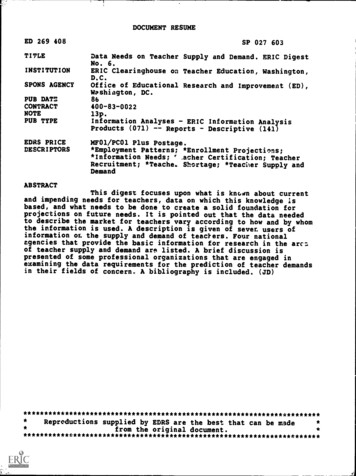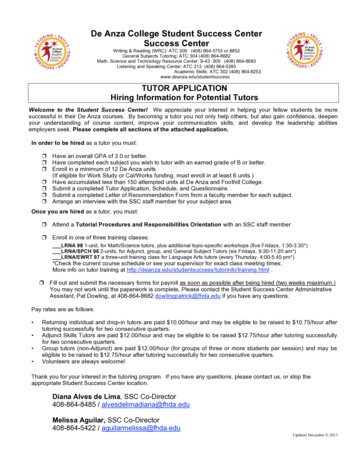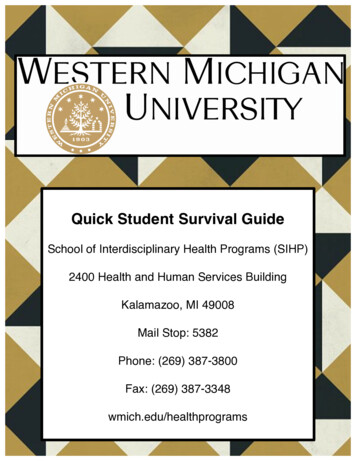
Transcription
DOCUMENT RESUMEED 269 408TITLEINSTITUTIONSPONS AGENCYPUB DATECONTRACTNOTEPUB TYPEEDRS PRICEDESCRIPTORSSP 027 603Data Needs on Teacher Supply and Demand. ERIC DigestNo. 6.ERIC Clearinghouse on Teacher Education, Washington,D.C.Office of Educational Research and Improvement (ED),Washington, DC.86400-83-002213p.Information Analyses - ERIC Information AnalysisProducts (071) -- Reports - Descriptive (141)MF01/PC01 Plus Postage.*Employment Patterns; *Enrollment Projections;*Information Needs; r .acher Certification; TeacherRecruitment; *Teache. Shortage; *Teacher Supply andDemandABSTRACTThis digest focuses upon what is knGyin about currentand impending needs for teachers, data on which this knowledge isbased, and what needs to be done to create a solid foundation forprojections on future needs. It is pointed out that the data neededto describe the market for teachers vary according to how and by whomthe information is used. A description is given of seven users ofinformation on the supply and demand of teachers. Four nationalagencies that provide the basic information for research in the arc:::of teacher supply and demand art% listed. A brief discussion ispresented of some professional organizations that are engaged inexamining the data requirements for the prediction of teacher demandsin their fields of concern. A bibliography is included. *************************Reproductions supplied by EDRS are the best that can be madefrom the original ******************************
DIVESTCLEARINGHOUSEON TEACHEREDUCATION1986DATA NEEDS ON TEACHER SUPPLY AND LEMANDCOOCTCOwitU.S. DEPARTMENT OF EDUCATIONOffice of Educational Research and ImprovementEDUCATIONAL RESOURCES INFORMATIONCENTER (ERIC)O This document has been reproduced asreceived from the person or organizationoriginating it.O M'rsnges have been made to improvereproduction qualityPoints of viow or opinions stated in this dccu-ment do not necessarily represent vfficialOERI position or policyDERIMee cl Edema&litiaard) alitIrgetwernertThis publication was prepared with funding fromthe Office of Educations] Research and Improvement,U.S. Department of Education, under contract no.400.83-0022. The opinions expressed iA this reportdo not necessarily reflect the positions or policiesof OERI or the Department.2ERICEducations) Resources Information Center: Thenationwide Information system initiated in 1966by the U.S. Department of Education. ERIC isthe largest and most frequently use4 educationdata base in the world.
DCLEARINGHOUSEON TEACHEREDUCATIONERIC DIGEST1kDATA NEEDS ON TEACHER SUPPLY AND DEMANDIs there a shortage of teachers today--or a surplus?nut year, or five years from now, or ten?What aboutWithout valid, reliable,and comparable data on the supply and demand of teachers nationwide,generalizations about national teacher shortages and surpluses aredifficult to support.Changes in population trends have sparked speculation on thesupply and demand for teachers.At stake are the interests of wouldbeteachers, teacher education institutions, state agencies, schoolboards, and the public.But data on the supply and demand of teachersremain largely uncollected, scattered among local, state, federal, andprivate agencies.1,The hollowing describes what is known about current and impendingneeds for teachers, data on which this knowledge is based, and whatneeds to be done to create a solid foundation for projections.Supply and Demand,Shortage and SurplusDemand for teachers stems from five basic situations according to3
the National Education Association (1982) and the Center forstatisticas (Plisko and Stern 1985).Increases in student enrollmentnecessitate opening more classes or schools.Changes in school policyQualified-teachers are needed to replaceexpand curriculum offerings.those with temporary or provisional certification.retire.Senior teachersYownger teachers quit to raise families, move to otherschools, continue graduate work or change careers.Demand can bereduced by decreased student enrollment, reductions in curriculumneeds, delayed retirement, and lcw incidence of teacher mobility.The supply of teachers comes from three general sources:certified graduates of stateaccredited teacher education programs whoseek teaching jobs, the re-erve pool of former teachers who havemaintained certification and intend to reenter the profession, andpersons who wish to teach and are academically qualified to becertified on a temporary, provisional, or emergency basis.A teacher shortage occurs when the demand for teachers exceeds thesupply of teacher applicants with requisite certification andi,qualifications A teacher surplus occurs when the supply of qualified:.teachers actively seeking employment is greater than the positionvacancies in their areas of certification.Meaningful discussion of teacher supply and demand must be tied tocertification and verifiable expertise and to geographic location (Akin1985;Berryman 1985).Significant differences exist among states,counties, and even school districts in the availability of and thedemand for teachers certified for different subjects and school grade4
levels.The Users and Uses of Supply/Demand InformationThe data needed to describe the market far teachers vary accordingto how and by whom the information is used.seven user'1.The following categorizes.f information on the supply and demand of teachers.Institutions of higher education use teacher supply and demandtrends to develop programs of teacher preparation, to recruitand advise students on career potential, and to maintaincooperative programs with school districts and local schoolpersonnel.2.Local school districts use supply and demand information forrecruitment, teacher assignments, staff development programs,budgetary decisions, and use of facilities.3.State education agencips use supply and demand data forI,educational policy dexilopment, fiscal proposals andallocations, and certification decisions (such as theinstitution of emergency certification).4.Federal and other national education agencies base budget andpolicy decisions on teacher market estimates.5.Teachers and administrators use the information to formulatetheir own career plans--to move to another area, to pursue an5
advanced degree, to change careers.Public groups, such as professional organizations and media, use6.supply and demand data to promote social agendas and to raisepublic concern for education issues.Individuals* such as researchers, students, and voters, need7.reliable supply and demand data to make informed jt. gments intheir areas of interest.That each of these groups needs access to reliable data suggeststhat supply and demand data be compiled at a national disseminationcenter.In addition, the diverse uses to which these data are appliedrequire that they be retrievable in precisely defined units.Becausethe information comes from local school districts, collecting it is animmense, complex effort that can be supported only at the nationallevel, according to Berryman (1985) and the Committee on NationalStatistics (1985).1,A Question of DataData on student enrollment are the only widely available figuresrelated to teacher supply and demand.Enrollment in elementary andsecondary schools according to grade level is the basis for teacherdemand studies.Enrollment in teacher preparation programs ;t collegesand universities provides thi foundation for teacher supply studies.Both kinds of databroadly categorized, are collected by the U.S.6
Department of Education's Center for Statistics (CS, formerly theNational Center for Education Statistics, NCES).studies from the U.S.Using populationBureau of the Census, the Center for Statisticsprojects student enrollment.A comparison of Simon and Frankel f.1976)with Plisko and Stern (1965) shows CS's predictions to be fairlyreliable over a five to telyear span.Unforeseen population mobilityand immigration trends complicate the predictions.Student enrollment provides only a fraction of the informationneeded to study teacher supply and demand.Projections of teaches'demand also are dependent upon predictions of the supply ofFilling teacher vacancies requiresappropriately qualified teachers.applicants specifically qualified for the postions open.Much more supply and demand Jata are available which have beencategorized by geographical and subject areas, but these remainuncollected.Collection methods and usable formats for data storageand categorization have yet to be designed.Figures necessary tocalculate a major part of potential teacher supply by geographic areaI,and well7defined subject of expertise could be abstracted fromenrollment in teacher preparation programs, but most states do notcollect these figures.Another estimation of teacher supply exists inteacher certification records .at state departments of education;however, because states use many different criteria and procedures forcertification, there is wide variance in just what certification meansin terms of a teacher's preparation.Two categories of data are essential to determine accurate7
estimates of supply and demand:a prer:ise list of teacher vacanciesand the certification records of teachers hired to fill.thosevacancies.These data must show the need for teachers by school grade,academic subject, and geographic location to be applicable to all kindsof users and uses.A record of the qualifications of the teacher hired to fill eachspecified vacancy would provide precise information on shortages.Wasthe 3hysics teacher vacancy filled by a teacher certified in physics?Or was the teacher hired certified in general science because nophysics teacher could be found?Did the third grade teacher whotransferred from the high school that closed last year ever have anyelementary teacher preparation?Obtaining this type of informationwould be a monumental task, but the precise definition of the datawould ensure valid, reliable, and comparable data nationwide.Precision and consistency in defining teacher certificationrequirements used by the states is essential for valid data (Berryman1985;Committee on National Statistics 1985).ft,Current SOurces of InformationFour national agencies provide the basic information for researchin the areas of teacher supply and demand.1.The Center for Statistics compiles and publishes "The Conditionof Education:A Statistical Report."Demandrelated data, suchas K-12 student enrollment, are sorted by state and byelementary and secondary schools, but have not been further8
categorized by grade levels and smaller geographic areas.Student enrollment in particular subject areas has yet to beexplored.Supply data includes studios of graduates of teachereducation programs with follow-up reports on employment statusone to five years after graduation.geographically categorized.These figures areIn the past, the Center has donestudies on teacher turnover categorized by broadly definedsubject areas and grade level.- -These studies did not receivesignificant geographical treatment.2.The Division of Occupational Outlook of the U.S.Department ofLabor gives current and projected demand and supply data forkindergarten, elementary, and secondary school teache-A in"Occupational Projection and Training Data."This is thelisting of staWtical findings on which the OCCUPATIONALThere is no breakdown of teacherOUTLOOK HANDBOOK is based.categories according to grade level, academic subject, orgeographic area.1,3.The National EducationAssociation complies and publishes"Teacher Supply and Demand in the Public Schools" which providesan extensive source of raw data from nationwide teacher supplyand demand studies.Both supply and demand data are separatedaccording to academic subject.Teacher supply data include numbers of students in teacherpreparation programs according to school grade levels andacademic areas.This information is used, along with studies of9
the teacher reserve pool and teacher turnover and retirementprojections, to form the basis for statistical predictions ofteacher supply.Because all students who become certifiedteachers do not become teacher applicants, the two groups aredifferentiated.The NEA data are not separated geographically and thecategoriJs used for data collection differ from year to year,making trend analyses and projections difficult.recent report available is 1982-83;The mostthe next report is expectedin mid-1986.4.The Association for School, College and University Staffing(ASCUS) has published "Teacher Supply/Demand" annually since1976 (for example, Akin 1985).The contents are based on anopinion survey of a representative sample of teacher placementofficers.The results show the perceived degree of teachersupply in 35 academic areas.Data are separated into ninegeographical areas plus Hawaii and Alaska.i,These survey results concur with the NEA reports and Athteacher supply and demand reports issued by state departments ofeducation (discussed below), documenting present shortages ofsecondary mathematics, science, and bilingual teachers and thefuture demand for elementary school teachers.In an unpublished study of current data available, the RandCorporation found that fewer than a dozen states publish inhouse10
statistical records on teacher supply and demand.lists four samples of state publications:The bibliographyWashington (Brouillet 1984),1985), Texas (Texas Education AgencyCalifornia (Cagampang et al.1984Y, and Utah (Utah State Office of Education 1984).Each coverscurrent and projected demand for teachers specified by academic area ofcertification and geographic area by county or school district.Eachquantifies and qualifies areas of shortage/surplus by documenting thepercentage of teachers teaching outside their areas of academictraining and by examining the reserve pool's probable activity.Statereports are not widely available and are seldom used in the literatureon teacher markets.Where to From Here?The need for accurate nationwide data has spurred someprofessional organizations to examine the data requirements for theprediction of teacher demands in their fields of concern.Manypublications question whetheuf,la teacher shortage--present orI,impending--can be based on currently available data (Berryman 1985).The National Research Council's Commission on Behavioral and.Social Science and Education formed the Committee on NationalStatistics to launch a project on the study of supply and demand forprecollege mathematics and science teachers.This project, funded bythe National Science Foundation and the Center for Statistics, examinedthe available data and found that too little data exist to formulateconclusions on teacher demand and supply in any area.11The committee is
compiling a description of data that need to be collected for adequateresearch on supply and demand.The project also includes a study ofproposed data collection and maintenance procedures and the explorationof statistical modelin,, and data processing methodologies.The nextcommittee report is expected this fall.The Institute for Educational Leadership (IEL) initiated aninderendent study of teacher market data last year.This study, fundedby the Ford Foundation, focuses on establishing criteria for data to begathered and on proposing a means of collecting national data fromstate departments of education, school districts, and other agenciesinvo:ved in the teacher market.Like The Committee on NationalStatistics, IEL is concerned with creating and implementing standarddefinitions for data categories and standardization of data collection.Last year, the Center for Statistics contracted with'the RandCorporation to redesign the national data base on schools and staffing.The general goals of the redesign are to institute dependablecollection methods, gather data more applicable to the current issuesi,of schooling and staffing, and present these data in formats moreuseful to researchers and school facility and policy planners.Objectives specific to the concerns of teachen supply and demandstudies include the identification of data (.Itegories 1.eeded toestimate key factors describing the teacher p.opulation and theacquisition of data needed to describe and monitor trends in schoolprograms, curricula, and staffing arrangements.More information onthe progress of the redesign should be forthcoming later this year.12
ReferencesAkin,J.N."'leacher Supply/Demand 1985." A Report Based Uponan Op'nion Survey of Teacher Placement Officers.Associationfor School, College and University Staffing, (1985).Berryman, S.E. "Knouledge About the Nation's Teachers, or: You'veLost the War If You Can't Find the Battlefield." FordFoundation,(1985).Brouill4t, F.B."Professional Education: Annual Report, SpecialTheme: Teacher Supply and Demand 1983-1984." State ofWashi3gton, Office of the Superintendent of PublicInstruction,(1984).Z.,.impang,H., et al. "Is the Reserve.)1 a Realistic Sourceof Supply." TEACHER EDUCATION QUARTERLY 12,4 (Autumn1985):13-44.SP 515 636.Committee on National Statistics (CNS). "Report of the PlanningConference for a Study of Statistics on Supply of andDemand for Precollege Science and Mathematics Teachers."Commission on Behavioral and Social Sciences and Education,National Research Council, (1985).National Education Association (NEA). "Teacher Supply and Demand inPublic Schools, 1981-82." NEA Research Memo, (1982).ED 235 135.Palaich, B. and D. Burnes."Teacher Shortages in the Next Decade."Issuegram 4 24.Education Commission of the States,(1983).ED 231 815.Plisko, V.W.and J.D. Stern, ed. "The Condition of Education: AStatistical Report. 1985 edition." National Center forEducational Statistics, (1985).ED 258 365.Simon, K.A. and M. M.Frankel!'"Projections of EducationStatistics to 1734-5." National Center for EducationStatistics,(1976). ED 119 372.Texas Education Agency. "Study of the Availability of Teachersfast. Texas Public Schools." Staff report to the StateBoard of Education,(1984).ED 246 033.U.S. Department of Labor, Bureau of Labor Statistics."OccupationalProjections and Training Data." A Statistical and ResearchSupplement to the 1984-85 edition of the OCCUPATIONAL OUTLOOKHANDBOOK, 198485 edition.Utah State Office of Education."Status of Teacher Personnelin Utah 1983-1984." (1984).ED 251 443.13
ED 269 408 SP 027 603 TITLE Data Needs on Teacher Supply and Demand. ERIC Digest. No. 6. INSTITUTION. ERIC Clearinghouse on Teacher Education, Washington, D.C. SPONS AGENCY Office of Educational Research and Improvement (ED), Washington, DC. PUB DATE. 86. CONTRACT 400-83-0022 NOTE. 13p. PUB TYPE Information Analyses - ERIC Information Analysis










